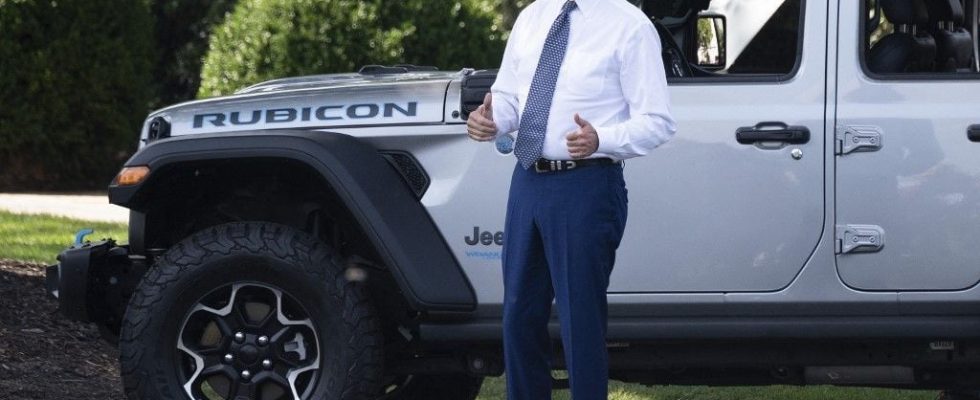A 180 degree turn across the Atlantic? The American government announced on Wednesday March 20 that it had finalized new standards on polluting emissions from automobiles, the strictest ever adopted. Objective: accelerate the transition to electric cars. Compared to the draft regulations announced last year, which has since been the subject of a public consultation, these final standards are more flexible and nevertheless give more time and flexibility to manufacturers to achieve the new emissions targets of CO2.
In the middle of an election year, President Joe Biden is playing a balancing act. And for good reason: it needs the support of the automobile industry and its employees. But it must also convince on its climate promises. Among them: ensuring that half of the cars sold in the United States in 2030 are electric. “I am pleased to announce the strictest pollution standards for vehicles ever taken in American history,” said Michael Regan, head of the Environmental Protection Agency (EPA). . On the contrary, his rival, Donald Trump, is waving the red rag in the face of the social consequences of decarbonization. “The American automobile manufacturing sector has created more than 100,000 jobs,” recalled the EPA.
In front of a huge flag of the United States, a country where cars are king, the head of the EPA assured: “I have always loved cars, and I always will.” The new standards concern light and medium vehicles built from 2027 to 2032. The administration does not set a precise quota of clean vehicles for sale, but gradually restricts the average annual emissions authorized for new vehicles from each manufacturer , thus encouraging them to electrify their fleet.
The threshold limit was relaxed for the first years (2027-2030), but ends in 2032 at the same level as previously envisaged. By that date, CO2 emissions standards will represent a reduction of about 50% compared to the standards for 2026 cars, the EPA argues. Many environmental associations welcomed the announced measures.
Transport: primary source of greenhouse gas emissions
Some experts have nevertheless accused the government of having given in to pressure from industry. The new standards “require fewer emissions reductions in the first years” compared to the initial proposal, regretted the Center for Biological Diversity. “This will send carbon pollution into the atmosphere sooner, and do more damage to the climate.”
Transportation is currently the country’s largest source of greenhouse gas emissions. The new standards should make it possible to avoid the emission of 7.2 billion tonnes of CO2 by 2055, according to the EPA. This represents around four times the emissions from the transport sector in 2021. The new regulations also affect emissions of fine particles, which are dangerous for health. A net profit of 99 billion dollars per year is expected, according to the government, including 13 billion thanks to health savings (avoided hospitalizations, etc.).
The auto industry welcomed the announcement. John Bozzella, of the Alliance for Automotive Innovation, welcomed the extension of deadlines decided by the EPA, highlighting the challenges encountered on the road to electrification, such as the need to develop new production lines. The standards for 2032 are “scary,” he said. But “the future is electric, and the manufacturers are determined”.
A ban”
Joe Biden’s Republican opponents have accused him of leading a crusade against gasoline cars, forcing “ordinary Americans to conform their way of life” to the elites, according to their leader in the Senate, Mitch McConnell. The American Petroleum Institute (API), representing the oil sector, even threatened to take legal action against the new regulations. This functions as “a ban” leading to “eliminating most new traditional gasoline and hybrid cars from the U.S. market in less than a decade,” she said.
Concretely ? It will be up to manufacturers to choose which technologies they adopt to reduce their emissions. They will be able to improve the efficiency of gasoline car engines, but above all determine their share of zero-emission (electric) or low-emission (plug-in hybrid) vehicles. According to EPA calculations, by the 2030s, electric vehicles could account for up to 56% of light-duty vehicles sold. That’s less than the 67% envisaged last year, with the EPA now adding plug-in hybrids to the options available to meet emissions targets. These could reach 13% of sales, the agency now projects.
An American fleet of 280 million vehicles
The slope remains steep for electric cars: in 2023, they represented only around 7.6% of vehicles sold in the United States, according to the Cox Automotive firm, or 1.2 million cars, out of an American fleet of 280 million vehicles. But “since 2021, sales of electric vehicles have quadrupled, and prices continue to fall,” argued Ali Zaidi, Joe Biden’s climate advisor.
Since the start of Joe Biden’s term, companies have announced more than $160 billion in investments in clean vehicles, according to the EPA. The Democratic president is also acting on other fronts: development of the network of charging stations, and adoption of tax credits for the purchase of electric cars. Will green bring him luck in the next elections?
